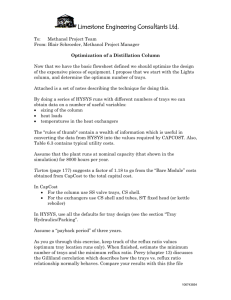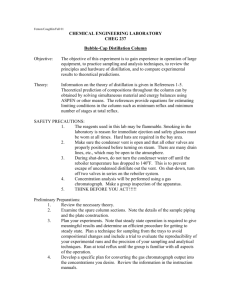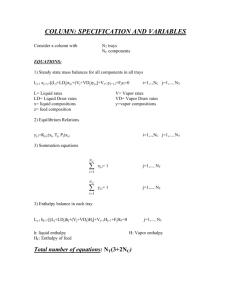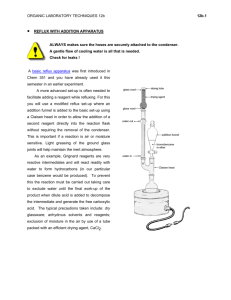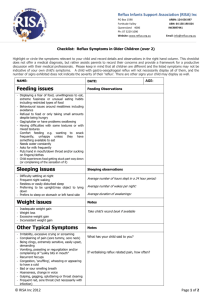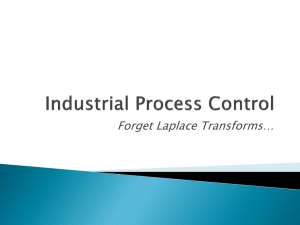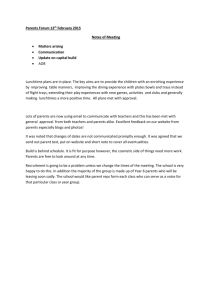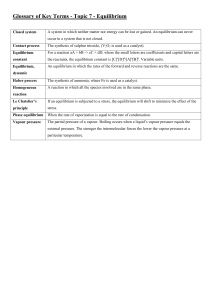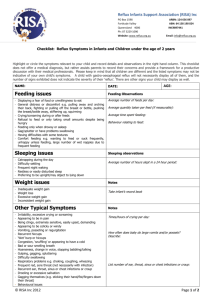The McCabe Thiele Graphical Design Method
advertisement
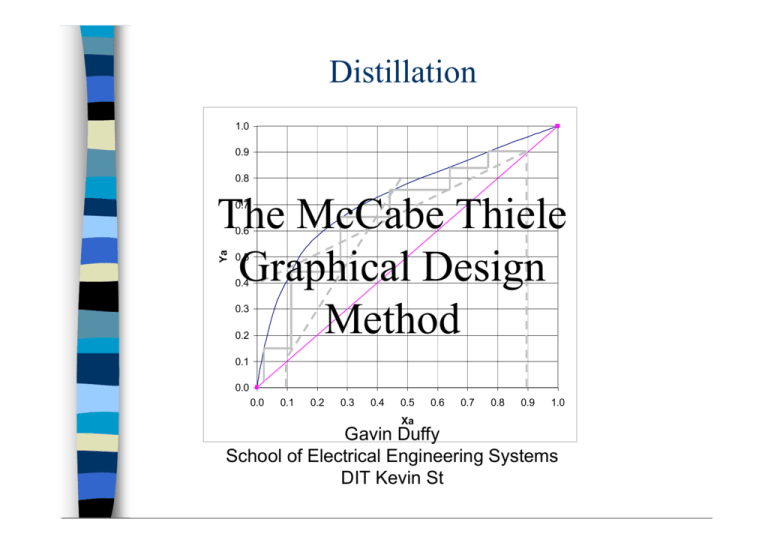
Distillation 1.0 0.9 0.8 The McCabe Thiele Graphical Design Method 0.7 Ya 0.6 0.5 0.4 0.3 0.2 0.1 0.0 0.0 0.1 0.2 0.3 0.4 0.5 0.6 0.7 0.8 0.9 1.0 Xa Gavin Duffy School of Electrical Engineering Systems DIT Kevin St Learning Outcomes After this lecture you should be able to….. •Explain the importance of Reflux •Apply the McCabe Thiele graphical design method to determine the number of equilibrium stages in a column •Describe column internals (trays and packing) •Define tray efficiency •Explain the height of packing equivalent to a theoretical plate Thanks to Ming Tham’s website for pictures and information. An excellent presentation on distillation: http://lorien.ncl.ac.uk/ming/distil/copydist.htm Design Illustrated slope= (VB +1) /VB 1.0 slope=R/(R+1) 1. Obtain VLE curve 2. Pick distillate composition, XD, and Reflux ratio, R, and draw operating line for rectification 0.9 0.8 6 5 0.7 3. Pick bottoms composition, XB, and Boilup ratio, VB, and draw operating line for stripping 4 Ya 0.6 3 0.5 0.4 4. Start stepping off from the distillate end until the intersection of the two operating lines is passed. 2 XD/(R+1) 0.3 0.2 5. Continue stepping but use the stripping operating line 1 0.1 0.0 0.0 0.1 XB 0.2 0.3 0.4 0.5 Xa 0.6 0.7 0.8 0.9 XD 1.0 6. Count the number of stages 7. Subtract one for the reboiler to give the number of theoretical trays (or leave as safety factor) Reflux Considerations R= Flow returned as Reflux Flow of top product taken off The rectifying operating line slope depends on R. Therefore, the number of stages required for a given separation depends on R. Effective reflux ratio can be greater than R if the column is poorly insulated and may be subject to change due to weather conditions. A well lagged column is more consistent. The amount of reflux lies somewhere between the two extremes of total reflux and minimum reflux Reflux Considerations The two extremes are Total Reflux and Minimum Reflux Total Reflux - all condensate is returned, no product is taken off and no feed added. This gives the minimum number of stages to achieve the separation. Minimum Reflux - reducing R requires more stages to achieve the separation. Further reduction creates a pinch point where an infinite number of stages is required. Minimum reflux happens when the intersection of the operating lines lies on the equilibrium curve Total Reflux All vapour is condensed and returned as liquid Minimum number of plates Can use Fenske equation to calculate Nmin N min xD (1 − xB ) ln xB (1 − xD ) = −1 ln α (Ref. Unit Operations, McCabe Smith, 6th ed. p666) Sometimes a column is operated in total reflux at startup Minimum Reflux Min Reflux happens when the two operating lines intersect on equilibrium curve 1.0 0.9 0.8 0.7 Ya 0.6 0.5 0.4 0.3 0.2 0.1 0.0 0.0 0.1 XB 0.2 0.3 0.4 0.5 Xa 0.6 0.7 0.8 0.9 XD 1.0 Minimum Reflux Don’t forget the q line. Min reflux occurs at intersection with equilibrium curve because all three lines should intersect 1.0 0.9 0.8 0.7 Ya 0.6 0.5 0.4 0.3 0.2 0.1 0.0 0.0 0.1 XB 0.2 0.3 0.4 0.5 Xa 0.6 0.7 0.8 0.9 XD 1.0 Minimum Reflux Can also be calculated (if feed is liquid at b.p.) Rmin 1 xD α (1 − xD ) = − (α − 1) xF (1 − xF ) Or, using definition of slope of line = R/(R+1) Rmin xD − y ' = xD − x ' Where x’, y’ is the intersection of line with curve Optimum Reflux Ratio (From McCabe Smith Ch21) Increase R Diameter gets bigger – Since D = fn(V, L) – R ↑ ⇒ V & L ↑ ⇒ D ↑ ∴ Capital Cost ↑ No. of Plates gets smaller – Height ↓ ∴Capital Cost ↓ Heat exchangers get bigger – Boiling/Condensing ↑∴ Capital & Running Cost ↑ Optimum Reflux Ratio Optimum Reflux Ratio Min Reflux Ratio Annual Cost Total Cost Operating Cost Captial/Fixed Cost 1.0 1.2 1.4 Reflux Ratio 1.6 1.8 2.0 Reflux and Cost A trade off between operating cost and capital cost is needed. Increase R ⇒ Less stages, less capital cost BUT also ⇒ More boiling and condensing Decrease R ⇒ More stages, More capital cost BUT also ⇒ Less boiling and condensing Capital and operating costs combine to give a total cost. This is minimised with the following Rule of thumb - R = 1.1 to 1.5 times Rmin R determines the slope Change in slope means less or more stages. As R increases the slope approaches 1. More MVC returned to the column. Less material is removed as distillate. Separation improves, fewer trays needed As R is decreased, the slope decreases towards the equilibrium line. A ‘pinch’ between operating and equilibrium lines becomes more pronounced and more and more trays are required Activity – Reflux Ratio Think, Pair, Share the following: Calculate R for the Acetic Acid/Acetic Anhydride system from last week. Reflux Control Source: http://www.controlguru.com/wp/p68.html McCabe Thiele Method Developed in 1925 Suitable for binary mixtures in continuous columns Can be used as a preliminary study for multi component Combination of VLE data and operating lines Assumes: Constant molal overflow No heat loss from column Not suitable if: Relative volatility is < 1.3 or > 5 Reflux ratio < 1.1 Rmin More than 25 theoretical stages needed Specifications required The following information is needed F Total feed rate zF Mol fraction of MVC in the feed P Column operating pressure xD Mol fraction of MVC in the distillate xB Mol fraction of MVC in the bottoms R/Rmin Ratio of reflux to minimum reflux Results provided McCabe Thiele provides the following results D Overall distillate flowrate B Overall bottoms flowrate Nmin Minimum number of equilibrium stages Rmin Minimum reflux ratio (Lmin/D) R Reflux ratio (L/D) VB Boilup ratio (V/B) N Number of equilibrium stages xn, yn Vapour and liquid compositions at each of the stages Design Procedure Start with VLE data and draw an x-y diagram Determine the three operating lines and draw them on the x-y diagram Using the rectifying operating line and the equilibrium curve draw steps from the distillate composition to the feed point Count the number of steps. Each one equals an equilbrium or theoretical stage Using the stripping operating line and the equilibrium curve draw steps from the bottoms composition to the feed point Add the number of steps to the previous to give the total number of equilibrium stages Convert this to a number of plates by dividing by the plate efficiency. Design Illustrated slope= (VB +1) /VB 1.0 slope=R/(R+1) 1. Obtain VLE curve 2. Pick distillate composition, XD, and Reflux ratio, R, and draw operating line for rectification 0.9 0.8 6 5 0.7 3. Pick bottoms composition, XB, and Boilup ratio, VB, and draw operating line for stripping 4 Ya 0.6 3 0.5 0.4 4. Start stepping off from the distillate end until the intersection of the two operating lines is passed. 2 XD/(R+1) 0.3 0.2 5. Continue stepping but use the stripping operating line 1 0.1 0.0 0.0 0.1 XB 0.2 0.3 0.4 0.5 Xa 0.6 0.7 0.8 0.9 XD 1.0 6. Count the number of stages 7. Subtract one for the reboiler to give the number of theoretical trays (or leave as safety factor) Activity – Count no. of stages Think, Pair, Share the following: Determine the number of equilibrium stages needed to effect the specified separation for the Acetic Acid/Acetic Anhydride system Is it OK to use equilib curve and op line? I know the no. of equilibrium stages The hard work is done at this point. The no. of equilibrium stages must be converted to a number of actual real plates. Typical values for tray efficiency are 0.5 to 0.75, I.e. they are 0.5 to 0.75 times as effective as an ideal stage. Divide the number of ideal stages by the efficiency. Don’t forget the boiler. This counts as one ideal stage. Delete 1 or leave it in as a safety factor. Add 10% extra trays. Trays and Plates Trays and plates encourage vapour liquid contact so that falling liquid partially vaporises and rising vapor partially condenses to create more equilibrium stages. This involves heat transfer which takes time. The plate provides an environment in which this can happen. Trays should aim to minimise pressure drop. The main designs are…. Bubble cap Sieve tray Valve tray The Bubble Cap Tray A number of small caps mounted on a riser. The cap is wider than the riser so the vapour flows up the riser and is then forced down around it on to the tray. A shallow pool of liquid is retained on the tray by means of a low weir. The area of the riser and the annular area between the riser and cap should be kept equal so the flowrate is not restricted. Trays suit medium to large sized columns (0.3 to 5m). On small diameter columns, installation and cleaning is difficult Bubble cap trays The Sieve Tray Sieve tray - a horizontal perforated sheet with a weir on one side. Same diameter as the column. The vapour passes through a shallow pool of liquid. The Valve Tray Like the sieve tray. A number of perforations but each perforation is covered by a flap or valve which is only lifted by the vapour flow. The tray may be modified to contain risers like the bubble cap tray in which case the valve sits on top of the riser. Vapour flow depends on the flow rate itself, these trays can operate over a wide range of flow rates. It is not necessary to replace the trays if the flow rate is changed. Valve trays Problems with Trays Adverse vapour flow conditions can cause…. Coning - liquid rate too low. Vapour forces liquid away from slots and passes through as a continuous stream. No mixing Dumping - vapour rate too low. Some slots dump liquid and don’t pass vapour. Vapour accumulates and eventually passes as a pulse. Weeping - combination of pulsating vapour flow and dumping. Problems with Trays contd… Flooding - vapour rate too high. This creates hold-up of liquid on the plate. Creates an increase in column pressure drop. Entrainment - high vapour flow carries liquid back up the column to the previous tray. Foaming - liquid expands due to passage of vapour. Although a large vapour liquid interfacial area is created, foaming can cause severe hold up of liquid on a tray. The vapour rate must be adjustable to get it right Tray Efficiency - Murphree For an ideal tray, the vapour leaving is in equilibrium with the liquid leaving. This may not happen in practice. The Murphree efficiency is defined as: EMv yn − yn −1 = ye − yn −1 Where Emv = Murphree efficiency for vapour yn = actual vapour composition of tray n yn-1 = actual vapour composition of tray n-1 ye = vapour composition in equilibrium with liquid on tray n Packing Can be used instead of trays Very useful for small columns where installation of trays is difficult Packing typically has a lower pressure drop than trays which makes it favourable for vacuum columns Vapour liquid contact may not be as good. The liquid moves towards the walls and vapour flows more readily in the areas free of liquid. Redistributors may be necessary Quantity of height of packing = no. of stages x HETP HETP = height equivalent to a theoretical plate Types of Packing Pall rings, raschig rings and saddles are easily available They provide a large interfacial area and minimise short circuits for flow They come in different sizes – e.g. small and large pall rings Packing Support Install at base of column to hold packing and allow vapour to pass HETP The height of a particular packing that is equivalent to a theoretical plate does not just depend on its physical shape. The vapour flow rate up the column also affects this number. 1.5 to 2” sizes of common packings allow the same vapour velocity as a sieve tray and have a HETP of 0.3 to 0.6 m (Unit Ops, McCabe Smith, 6th Ed., p699) What improvements should this man make to his design? What would you say to him? (He is making Raki)
